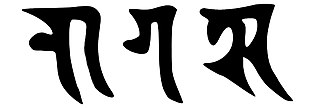
An abugida – sometimes also called alphasyllabary, neosyllabary, or pseudo-alphabet – is a segmental writing system in which consonant–vowel sequences are written as units; each unit is based on a consonant letter, and vowel notation is secondary, like a diacritical mark. This contrasts with a full alphabet, in which vowels have status equal to consonants, and with an abjad, in which vowel marking is absent, partial, or optional – in less formal contexts, all three types of the script may be termed "alphabets". The terms also contrast them with a syllabary, in which a single symbol denotes the combination of one consonant and one vowel.

Devanagari is an Indic script used in the northern Indian subcontinent. Also simply called Nāgari, it is a left-to-right abugida, based on the ancient Brāhmi script. It is one of the official scripts of the Republic of India and Nepal. It was developed and in regular use by the 7th century CE and achieved its modern form by 1000 CE. The Devanāgari script, composed of 48 primary characters, including 14 vowels and 34 consonants, is the fourth most widely adopted writing system in the world, being used for over 120 languages.

Gurmukhī or Gurumukhī is an Indic script predominantly used in present-day Punjab, India. It is an abugida developed from the Laṇḍā scripts, standardized and used by the second Sikh guru Guru Angad (1504–1552). It is commonly regarded as a Sikh script, used by Punjabi Sikhs to write the Punjabi language, and is one of the official scripts of the Indian Republic, while the Arabic-based Shahmukhi script is used in Punjab, Pakistan.

The Brahmic scripts, also known as Indic scripts, are a family of abugida writing systems. They are used throughout the Indian subcontinent, Southeast Asia and parts of East Asia. They are descended from the Brahmi script of ancient India and are used by various languages in several language families in South, East and Southeast Asia: Indo-Aryan, Dravidian, Tibeto-Burman, Mongolic, Austroasiatic, Austronesian, and Tai. They were also the source of the dictionary order (gojūon) of Japanese kana.

Brahmi is a writing system of ancient India that appeared as a fully developed script in the 3rd century BCE. Its descendants, the Brahmic scripts, continue to be used today across Southern and Southeastern Asia.

The Gupta script was used for writing Sanskrit and is associated with the Gupta Empire of the Indian subcontinent, which was a period of material prosperity and great religious and scientific developments. The Gupta script was descended from Brāhmī and gave rise to the Śāradā and Siddhaṃ scripts. These scripts in turn gave rise to many of the most important Indic scripts, including Devanāgarī, the Gurmukhī script for Punjabi, the Bengali-Assamese script and the Tibetan script.
The Laṇḍā scripts, is a Punjabi word used to refer to writing systems used in Punjab and nearby parts of North India. In Sindhi, it was known as 'Waniko' or 'Baniyañ'. It is distinct from the Lahnda language varieties, which used to be called Western Punjabi.

The Nāgarī script or Northern Nagari is the ancestor of Devanagari, Nandinagari and other variants, and was first used to write Prakrit and Sanskrit. In modern-day, the term is sometimes used as a synonym for Devanagari script. It came in vogue during the first millennium CE.

Khudabadi was a script used to write the Sindhi language, generally used by some Sindhi Hindus even in the present-day. The script originates from Khudabad, a city in Sindh, and is named after it. It is also known as Hathvanki script. Khudabadi is one of the four scripts used for writing Sindhi, the others being Perso-Arabic, Khojki and Devanagari script. It was used by traders and merchants to record their information and rose to importance as the script began to be used to record information kept secret from other non-Sindhi groups.
Ja is the eighth consonant of Indic abugidas. In modern Indic scripts, ja is derived from the early "Ashoka" Brahmi letter after having gone through the Gupta letter .
A is a vowel of Indic abugidas. In modern Indic scripts, A is derived from the early "Ashoka" Brahmi letter after having gone through the Gupta letter . Bare consonants without a modifying vowel sign have the "A" vowel inherently, and thus there is no modifier sign for "A" in Indic scripts.
Ā is a vowel of Indic abugidas. In modern Indic scripts, Aa is derived from the early "Ashoka" Brahmi letter after having gone through the Gupta letter . As an Indic vowel, "Ā" comes in two normally distinct forms: 1) as an independent letter, and 2) as a vowel sign for modifying a base consonant. Bare consonants without a modifying vowel sign have the inherent short "A" vowel.
I is a vowel of Indic abugidas. In modern Indic scripts, I is derived from the early "Ashoka" Brahmi letter after having gone through the Gupta letter . As an Indic vowel, "I" comes in two normally distinct forms: 1) as an independent letter, and 2) as a vowel sign for modifying a base consonant. Bare consonants without a modifying vowel sign have the inherent "A" vowel.
U is a vowel of Indic abugidas. In modern Indic scripts, U is derived from the early "Ashoka" Brahmi letter after having gone through the Gupta letter . As an Indic vowel, U comes in two normally distinct forms: 1) as an independent letter, and 2) as a vowel sign for modifying a base consonant. Bare consonants without a modifying vowel sign have the inherent "A" vowel.
Ū is a vowel of Indic abugidas. In modern Indic scripts, Ū is derived from the early "Ashoka" Brahmi letter . As an Indic vowel, Ū comes in two normally distinct forms: 1) as an independent letter, and 2) as a vowel sign for modifying a base consonant. Bare consonants without a modifying vowel sign have the inherent "A" vowel.
Ṛ is a vowel symbol, or vocalic consonant, of Indic abugidas. In modern Indic scripts, Ṛ is derived from the early "Ashoka" Brahmi letter after having gone through the Gupta letter . As an Indic vowel, Ṛ comes in two normally distinct forms: 1) as an independent letter, and 2) as a vowel sign for modifying a base consonant. Bare consonants without a modifying vowel sign have the inherent "A" vowel.
E is a vowel of Indic abugidas. In modern Indic scripts, E is derived from the early "Ashoka" Brahmi letter after having gone through the Gupta letter . As an Indic vowel, E comes in two normally distinct forms: 1) as an independent letter, and 2) as a vowel sign for modifying a base consonant. Bare consonants without a modifying vowel sign have the inherent "A" vowel.
Ai is a vowel of Indic abugidas. In modern Indic scripts, Ai is derived from the early "Ashoka" Brahmi letter . As an Indic vowel, Ai comes in two normally distinct forms: 1) as an independent letter, and 2) as a vowel sign for modifying a base consonant. Bare consonants without a modifying vowel sign have the inherent "A" vowel.
O is a vowel of Indic abugidas. In modern Indic scripts, O is derived from the early "Ashoka" Brahmi letter after having gone through the Gupta letter . As an Indic vowel, O comes in two normally distinct forms: 1) as an independent letter, and 2) as a vowel sign for modifying a base consonant. Bare consonants without a modifying vowel sign have the inherent "A" vowel.
Au is a vowel of Indic abugidas. In modern Indic scripts, Au is derived from the middle "Kushana" Brahmi letter , and the Gupta letter . As an Indic vowel, Au comes in two normally distinct forms: 1) as an independent letter, and 2) as a vowel sign for modifying a base consonant. Bare consonants without a modifying vowel sign have the inherent "A" vowel.

















